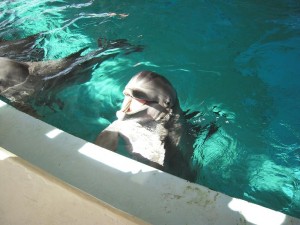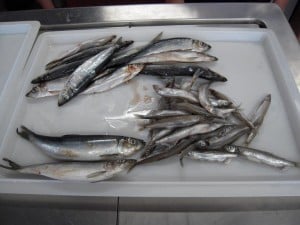Mercury in aquatic ecosystems
Note: The work described on this page represents a combination of completed projects and ongoing research. Please refer to our Publications page for a list of published articles.

Mercury (Hg) is globally ubiquitous and environmentally persistent. Both human activities — especially coal-fired power plants and mining operations — and natural processes (e.g., forest fires, volcanic eruptions) release this metal from naturally-occurring reservoirs. Once mercury has been mobilized, it is generally transported with sediment. When sediment eventually settles out at the bottom of water bodies like lakes and estuaries, the mercury is deposited as well. In these sedimentary environments, anaerobic bacteria transform the inorganic Hg to methylmercury, primarily mono-methylmercury (MMHg).
Unfortunately, MMHg is toxic, and it is readily transferred out of the sediment and into the overlying water column, where it is taken up by aquatic organisms. MMHg bioacumulates, so animals higher up the food chain are exposed to higher concentrations in their diet. Eventually the Hg is transferred to top predators, like dolphins, and it can have toxic effects on the species. To better understand mercury bioaccumulation, Dr. Bouwer’s group completed two research projects funded by the National Aquarium Conservation Center.
The first project studied the potential for dietary mercury exposure in Bottlenose dolphins. Bottlenose dolphins who live at the National Aquarium in Baltimore are fed a diet of capelin and herring caught in fisheries in the North Atlantic. Herring and capelin have relatively low mercury concentrations compared with many other species of fish. However, dolphins can eat 20 or 30 pounds of fish a day, so even if their food contains only low levels of mercury, they could be affected by continuous uptake of the toxic compound. Our study analyzed total mercury, selenium, and methylmercury levels in diet fish and assessed the dolphins’ Hg exposure. We found that Hg levels in the captive Bottlenose dolphins at the National Aquarium were lower than those that have been observed in a number of wild populations throughout the world. The captive dolphins’ diet at the National Aquarium did not carry unacceptable health risks due to Hg exposure.

The second project took an ecosystem approach to assess mercury bioaccumulation in resident Bottlenose dolphins in Sarasota Bay, Florida. Although Hg is usually present in very low levels in the environment, high Hg levels have been measured in a variety of small cetaceans around the world. How these marine mammals come to have such high concentrations of mercury in their bodies is not clear: there are many unresolved scientific questions about exposure pathways, bioaccumulation, and biomagnification. In collaboration with Dr. Randy Wells, director of the Sarasota Dolphin Research Program (Chicago Zoological Society / Mote Marine Laboratory), we selected Sarasota Bay as a model ecosystem, and the native resident bottlenose dolphin (Tursiops truncatus) as an example of a small cetacean.
Previous research in Sarasota Bay provided information about ecology, population structure and dynamics, and the health of the resident Bottlenose dolphins. Starting from such a robust data set minimized the uncertainties that arise from cetaceans’ unpredictable foraging habits, which can make it difficult to characterize Hg bioaccumulation in these species. Experimental work and mathematical modeling in the Bouwer group helped shed light on the fate and transport of Hg in Sarasota Bay and other ecosystems.
In a collaborative third project, the Bouwer group is currently working with researchers from Dolphin Island at Resorts World Sentosa (Singapore) and from Daegu University (South Korea) to evaluate the dietary mercury exposure of Indo-Pacific bottlenose dolphins. Similar to the study conducted at the National Aquarium in Baltimore, this project takes advantage of a captive dolphin population with extensive health monitoring and a carefully-controlled, responsibly-sourced diet. In the future, we may have the opportunity to extend the research to other top predators, such as sharks or manta rays. It is our hope that this initiative will lay the groundwork for a growing collaboration between top research and conservation organizations in Southeast Asia to support ongoing and future research into local marine species and ecosystems.
